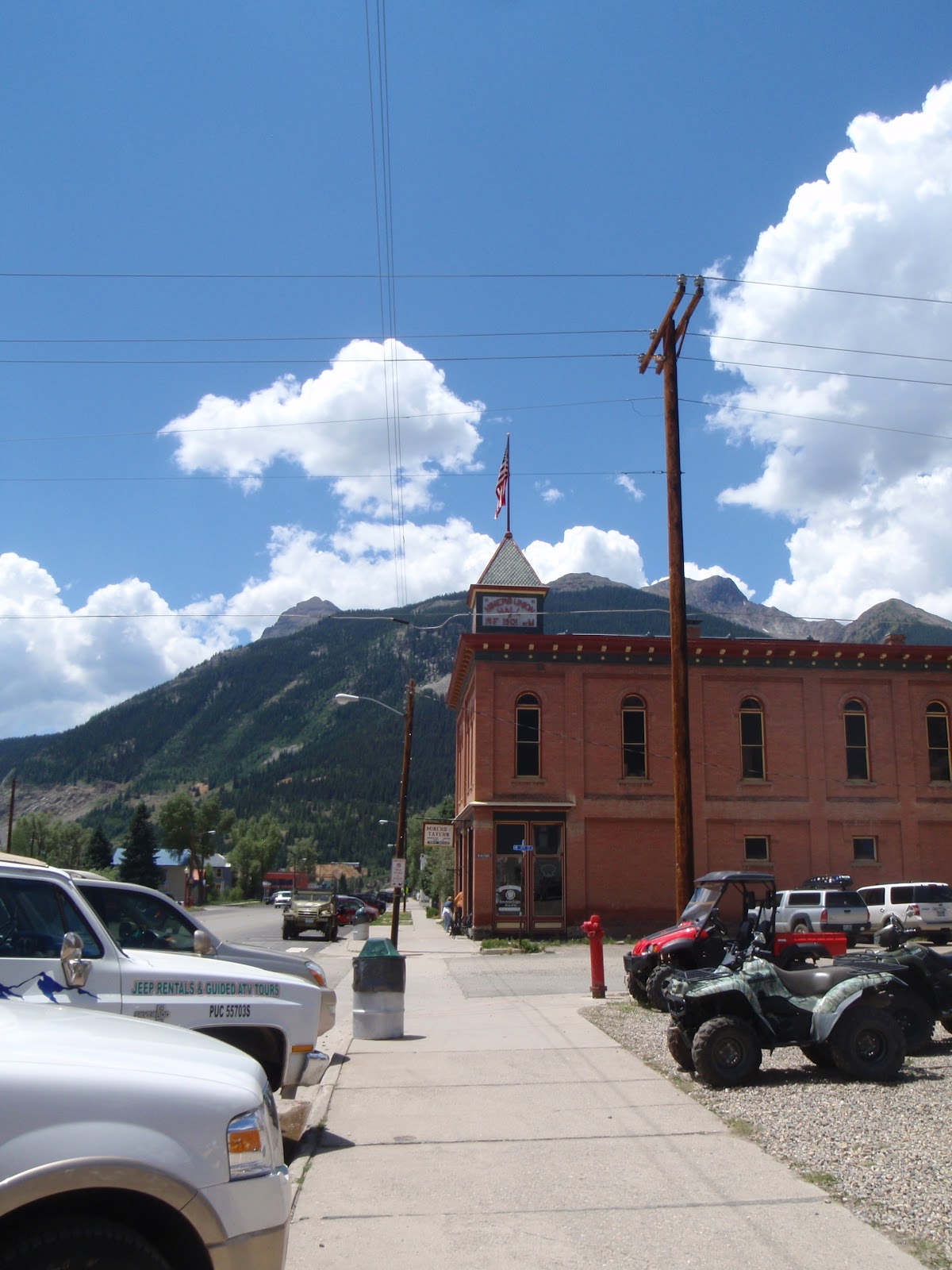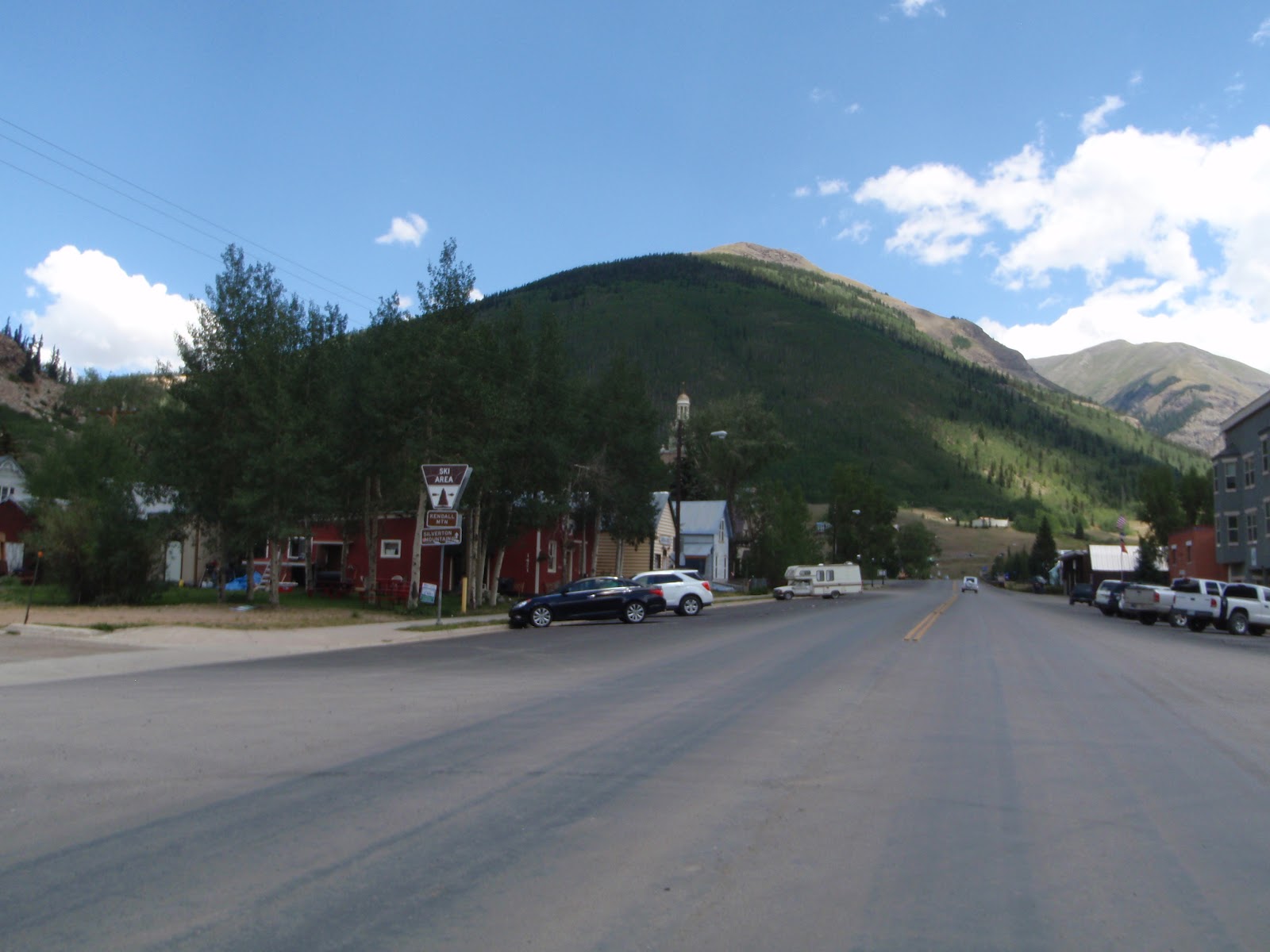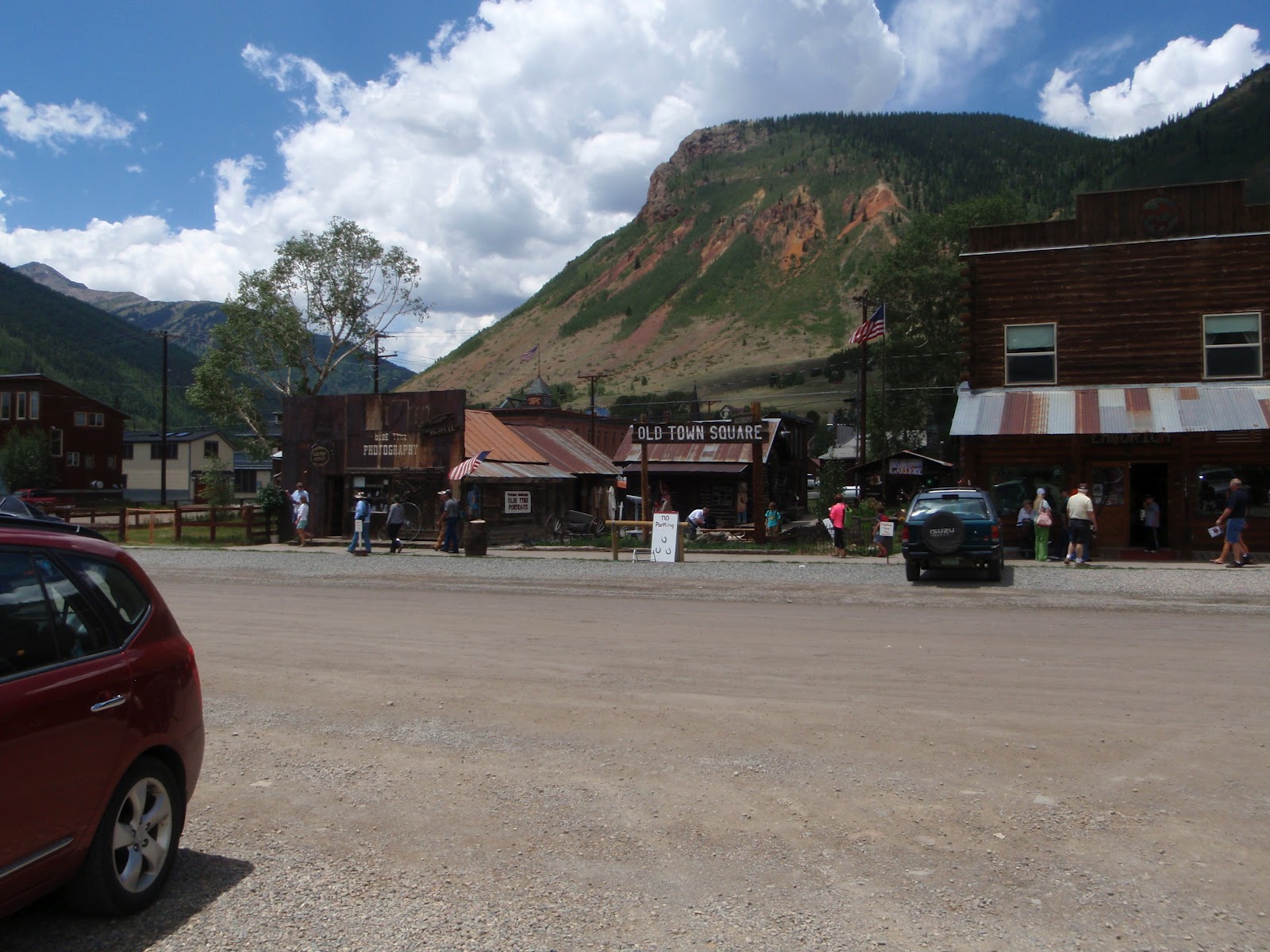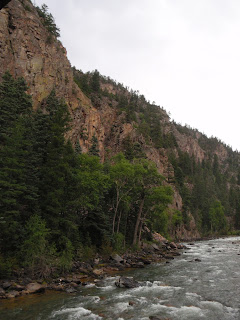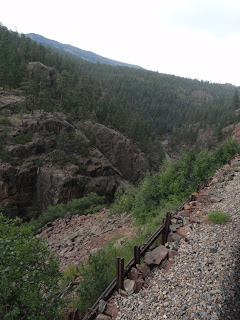DURANGO & SANTA FE ROAD TRIP
8 – 16 July 2012
We wanted to attend the International
Folk Art Market in Santa Fe, NM and decided to lengthen the trip by going
to Durango, CO to ride the Durango-Silverton
Train. We worked the travel dates around the market, picked a route, and
made reservations at Marriott hotels
along the way. Our route took us from Southlake to Amarillo via US287 and then
to Albuquerque via I-40.
We took I-40 west as we headed for Albuquerque. Before
reaching the New Mexico border we were amazed by two things: a huge feedlot
with acres of pens of cattle that included its own grain elevator; rows of wind
turbines that stretched for about 15 miles along the north side of the road. We
saw some plowed fields that probably grew wheat; some cotton fields; some
ranchland. The terrain changed from a virtually flat plain to one with a few
hills and valleys and then to one with mesas. After stopping at the “Visitors’
Center,” just over the state line, we drove through the area known as
“Mesalands.” Some areas are pretty in their contrasts: red soil; flat-topped
hills [mesas] that jut perpendicularly from the flat land; wide valleys with
stunted mesquite bushes and trees; splotches of grayish-green grass. Most of
the area looked to be used for holding the Earth together but was probably
ranch land. There were a few towns to the north of the highway and most of them
touted their claim to fame, “on US Route 66.” Since we entered the Mountain
Time Zone when we crossed the border, we lost an hour.
From Albuquerque, we drove US 650 all the way to Durango.
The drive was somewhat monotonous as the highway was fairly straight for most
of the way. The rolling terrain was somewhat interesting but arid. Hills,
mesas, canyons and arroyos provided almost the only scenery from the time we
left Albuquerque until we were almost to Bloomfield. It was a
four-land-divided-highway with a speed limit of 70 almost all the way. A few
places had slower speeds. There wasn’t
much vegetation except for scrub brush; stunted trees and grayish-green
needle-like grass. It was mostly bare ground and/or rock. In some places, the
sides of the hills and mesas showed strata of different colors of soil: gray;
black; white red; beige and all variations of those colors. We had been warned to watch for speed traps
in Cuba, but saw no law enforcement on the entire drive. We did see the “Cattle
Lack Feed Company” in Cuba. We crossed the Continental Divide and continued our
ascent with some elevations over 7000 feet. The farther North we drove, the
more gas wells we saw and some places only seemed to exist to be pump stations.
Much of the land is reservations of various tribes but it’s difficult to tell
which is and which is not. Most of the structures we saw looked temporary and
dilapidated. We saw hundreds of mobile homes. Although we kept looking for
livestock, we only saw about a half dozen head of cattle and a couple of dozen
horses. When we reached the San Juan River, we saw some green pasture with more
cattle and horses, and a bit of prosperity. Then we reached the towns of Bloomfield
and Aztec which are situated less than ten miles apart along the Animas River.
Here we saw lots of evidence of petroleum production with materials and
equipment available to do everything from preparing the location to drilling
the well and then completing the production and transport. Just outside Aztec,
we saw lots of irrigation and hay and silage production on small tracts along
the river. Once we crossed into Colorado, the entire area began to look more
prosperous and there was more irrigation along with more livestock. Here the
highway changed to a two-lane one.
DURANGO
We checked into the “Strater Hotel,” a historic structure on
Main Avenue. Our room, which is on the front of the building, was wallpapered
in what purports to be high-style-Victorian and contained all Victorian
furniture: bed, marble-topped dresser; side tables; marble topped lamp table;
marble topped stand to hold the TV; drop front secretary; marble topped coffee
table; settee; uncomfortable chair. It’s somewhat over-the-top. The hotel
claims to have one of the largest, if not the largest, collections of Victorian
furniture in the US; it’s everywhere. We left the hotel and spent a while walking
the street. There was a brief rain shower in the afternoon. We decided to have
dinner at “Jean Pierre.” What a great meal! A group of some 12 to 15
people and calling themselves the “Durango Barbershop Singers” came into the
restaurant and sang a couple of numbers before walking on up the street. We
caught up with them on the way back to the hotel and heard them a few more
times. We walked around downtown for quite a while; it was cool and pleasant
and we enjoyed being out.
DURANGO & SILVERTON NARROW GAUGE
RAILROAD
We arrived at the train depot around 7:30 and got our
souvenir train ticket; we already had the boarding passes which had come via
email. We waited until they opened the door to the tracks at 8:00 and then
boarded our car, “Cinco Animas,” the last car in the train. We had seats 3 and
4 out of sixteen seats in that car. We departed on time at 8:30 and the first
half hour or so were rather boring as we made out way out of Durango and
through a few other small towns; we had never seen so many manufactured houses
and mobile homes. There was some irrigation and we saw some cattle and horses
but the crop appeared to be hay. Sarah, our attendant, served drinks and a
cinnamon roll. We made our way north via the narrow gauge railway and the old
car really swayed, jerked and creaked. Fortunately, we were able to go onto a
rear platform or to an open car in the front which wasn’t fully occupied; that
gave us more viewing opportunities. Sarah was good at telling us when something
would soon appear. We enjoyed seeing the terrain and the various trees. The
tracks follow a river valley and we crisscrossed it all the way to Silverton.
The bright, sunny day enhanced the scenery.
Water in the river tumbled and swirled around rocks in areas of rapids
and flowed gently in others; a lower-than-average-rainfall provided a lower
than normal water level. We saw some waterfalls, bridges, old mines and rock
slides. We made three water stops as the coal burning engine requires lots of
water to create steam. Black smoke pours from the funnel and some cinders fly
but our car was enclosed.
After arriving in Silverton at noon, we walked directly
to “Thee Pig ‘Again’ Barbeque” where we enjoyed lunch. Then we walked the town
and made some photos. Only one street of Silverton is paved. There’s a city
hall and the San Juan County Courthouse; it’s the only town in the county.
Silverton’s elevation is at 9300 feet above sea level, and it receives 500
inches of snow annually. We were told that almost all the businesses close at
the end of October and many of the residents leave. During the winter, the
train only goes to Cascade which is about half way.
At 2:00, we reboarded
the train for the return to Durango. Some of the people in our car made the
return trip by bus, so we got a few new ones. We thought the most amazing
portion was the canyon of the Needle River---deep with rushing rapids. At one
point we saw some people in rafts but they weren’t in the canyon; the water
level is too low. We stopped at one point for staff to remove some rocks from
the rains to prevent derailment. It was about 5:45 when we arrived in Durango.
After dinner at "Jean-Pierre," we walked up and down Main Avenue
and made some photos. We had a great day and the train ride exceeded our
expectations.
We left Durango and drove east toward Pagosa Springs on 160.
We saw more manufactured housing today. The drive was through ranching country
and we saw several herds of horses and of cattle. Even travelers can tell that
less than normal amounts of rainfall are taking their toll on the vegetation.
At Pagosa Springs we turned South on US 84 which we followed all the way to
Santa Fe. The smooth two-lane highway undulated through mountains as we went
up, down and around, and the driving was easy.
Surprisingly, the highways in New Mexico are better than the ones in
Colorado. Much of today’s scenery appeared to be the reverse side of Tuesday’s.
There are some beautiful ranches but they’re very isolated. We found a Tourist
Information office at Chama. Then we headed on South. Espanola was the only
town of any size on our route.
SANTA FE
We reached Santa Fe about mid-afternoon. A huge clap
of thunder announced a brief rain about 3:30. We ate dinner at “Zia Diner.”
After eating, we located the parking lots for the shuttle bus pickups for the
Folk Art Market. The next morning we drove to the Historic Plaza Area of Santa Fe in time to arrive there about
10:00. After parking in a garage, we walked up San Francisco Street toward the
Plaza. Some of the stores don’t open until 11:00 but most opened at 10:00. We
window shopped a lot. Around noon, we were tired and needed to rest so we went
to lunch at “Blue Corn Café.:” It had warmed some and we were done for the day,
so we headed back toward the car. Then we drove back toward the hotel. We
decided that we need breakfast tomorrow morning because we need to leave the
hotel before it opens, so we stopped at “Whole Foods.” Imagine having to fight
your way into and out of a grocery store parking lot! We returned to the hotel
to relax until time for tonight. About an hour after we got back to the hotel a
little shower of rain fell.
INTERNATIONAL FOLK ART MARKET
The “Market Opening and Party” of the International Folk Art Market began at 6:30 Friday night. The
market provides a retail outlet for artisans---many of them cooperatives---in
their native countries and provides scholarships to some artisans. Since there
is no parking allowed on “Museum Hill” during the market, free shuttles operate
from a couple of locations; we chose the “South Capitol” location because it
was closer to our hotel. Information said the shuttles would begin operating at
6:00, and we were in line waiting for the first bus. We actually left the lot
early and were in line at the market before 6:00. They opened promptly at 6:30
and we were fairly close to the beginning of the line; supposedly tickets were
limited to 2000 on a
first-come-first-served basis and we believe every one of those was
sold. There should be a better way to
allow entrance as this creates a rush at the gate and into some of the booth
areas. Upon entering the market, we made
our way to the upper portion and worked our way through the 134 booths. Booths
are numbered and arranged in rows under tents; most tents have 4 rows of
booths. Each booth also has at least one volunteer to help the artisan and
another to write up the purchases. Once an item is selected for purchase, the
volunteer completes paperwork with the booth number, buyer’s name and cellphone
number and then bags the item and staples a copy of the paperwork to the bag.
The buyer receives three copies of the paperwork and takes those to a payment
area. Once the items is paid for, the buyer receives a copy of the paperwork to
keep and another copy stamped “paid” to be taken to the booth to retrieve the
item. Tax is charged on all items. We
enjoyed seeing the high-quality products and the artisans, many of them in
native dress. While there was a wide variety of items, we did not find
nativities as we had hoped. We skipped the many stalls from Mexico, India and
Peru as we already have a plethora of items from those countries. Items are not
cheap; many are very expensive, at least to our way of thinking. There was free
finger food and drinks---alcoholic with an armband. Basically, we shopped and did
a little snacking. Although it clouded up and threatened rain, none fell. We
managed to cover the entire market before catching a shuttle bus at 9:15.
We had “early bird tickets” for Saturday’s market and left
the hotel around 6:30. That meant we had to provide our own breakfast in the
room from yesterday’s purchases at “Whole Foods.” We returned to the same
shuttle pickup area and boarded the first bus. We were a little farther back in
line this morning but got in soon after the 7:30 opening. The market was not
nearly as crowded this morning and items did not appear to be picked over.
Also, daylight is better than artificial light for some items. We shopped the
entire market again and made some purchases. Food and drink cost today. By
9:30, it was beginning to feel warm and we were ready to leave. We took a
shuttle back to the parking area and returned to the hotel. Around noon we
drove about 12 miles north of Santa Fe to Cuyamungue for lunch at “Gabriel’s.”
Then we drove a few miles farther north to “Don Quixote Distillery” in
Pojoaque, maker of “Blue Corn Bourbon.” The distillery isn’t easy to get to
from the south and we had a scenic tour of a reservation---complete with lots
of speed humps---trying to find it.
JOURNEY HOME
We headed south from Santa Fe on US 285 and drove through
more ranching country. You could get lonesome here very quickly. The panoramas
are pretty but the up-close scenery is not. We did see some herds of cattle but
saw no person except those in other vehicles. Traffic was sparse. At Clines
Corner we intersected I-40 and headed east through the same terrain we
traversed last Monday. There was more traffic today with westbound being
heavier than eastbound. On that side, the ratio of trucks to cars was at lest
six-to-one. On our side there were more cars than trucks and most of them
sported license plates of states to the east. The entire trip totaled
1744.3 miles.













































